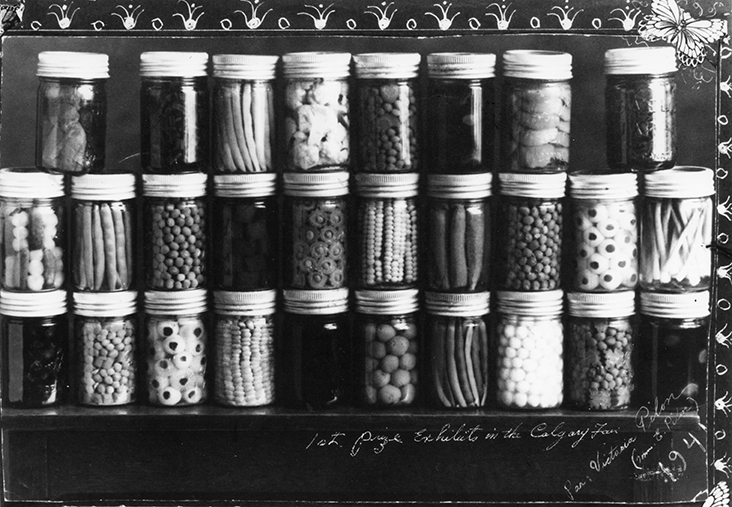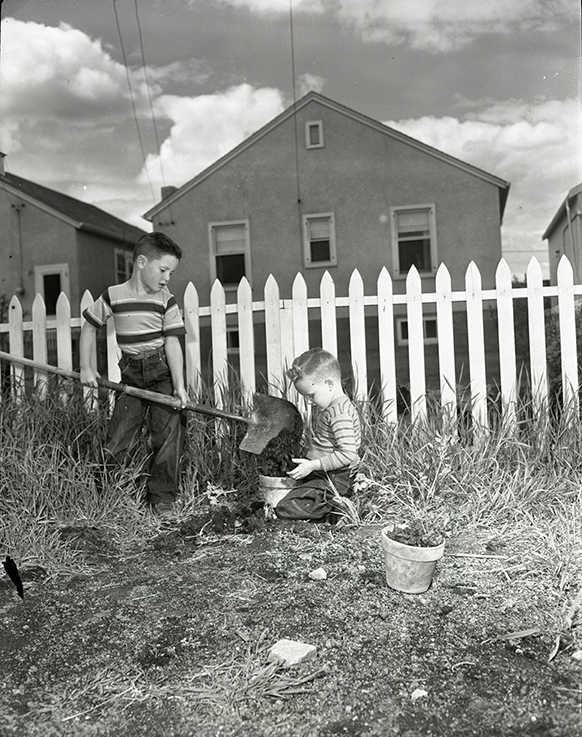With the last blast of winter gusto already forgotten and double-digit weather on the horizon, now’s the time to start some seeds! Sunflowers are easy, peas like a good soak before setting in the soil and don’t bother with basil. Just get it at the greenhouse, my mother says. It’s too fussy. When I was a kid, a timeworn French-Canadian couple provided space for our family to grow a garden. Leonard Marquis’ was a man of the earth, his hands the size of shovels. Jeanne Marquis canned everything that passed her doorstep and kept the dirt off the floors with vigor. Having no children of their own, we little ones had struck it rich. Resplendent in our bare feet walking between the garden rows, munching on carrots pulled straight from the soil or peas so fresh they tasted like the colour green. I simply cannot remember a safer place or kinder people. It was the garden that connected us and filled in the empty spaces, heedless of generational and cultural differences the Marquis’ fed us and loved us as their own. Sowing seeds of the heart.
This memory had me pondering the grandmothers and grandfathers on Alberta farms who’d lost sons to war, their daughters to the flu pandemic. Did Grandma peer out the backdoor of the farmhouse, eyes resting for a moment on the tree swing, thinking fondly of little hands that once helped dig and plant? Did the extra bushels dropped on the doorstep of the struggling family next door help Grampa feel useful again? What can we learn from the gardeners of our past to help us endure our present predicament?
From the fur trade era to modern times, gardens of varying scale were maintained throughout this river city. Early on, before fur traders conceded the flats would flood, encampments were constructed close to the river’s edge. In the darkest of silts, newcomers grew their first gardens. Water, gravel, sand and soil: the greatest gifts an ancient alluvial channel could offer and the ideal nutrient base for agricultural success. Edmonton House held the crown for agricultural output on the prairies through the 19th century with astounding quantities of vegetables, barley and oats growing here since first settlement.

By the 1870s, HBC leaseholder Donald Ross had built a large greenhouse close to where Diamond Park (Re/max Field) now stands. He and his wife, Olive, were prolific gardeners winning ribbon after ribbon for their produce at the local agricultural fairs. The Ross Estate was eventually divided into city sized lots, yet families continue to benefit from the toil of green thumbs past. Not so much as a pebble can be found in the flowerbeds of Rossdale.
Large scale gardens blanketed valley and cliff on both sides of the river. To the east at river lot 42 lived another gardener of renown, Beata Humberstone. She was the wife of coal magnet William Humberstone, whose various mines supplied the HBC fort for many years. No less a champion in produce circles, Beata’s cabbages were said to be the diameter of a wooden oxcart wheel. Beata’s gardens fed local families, newcomers, and mine workers living at the Humberstone rooming house. The 200 hundred acres of fertile lands were eventually taken up by the Prins who also had a penchant for horticulture, introducing Edmontonians to the illustrious cauliflower! Gardens are part of our history, our legacy of labour in return for plenty.

As city lands passed from hand to hand, to new families, and more modern enterprises, the grand gardens of old were intersected with roadways, subtracted into suburban size allotments. Backyard gardens soon became the norm. In 1909, a group of citizen gardeners founded the Edmonton Horticulture Society: a gathering of ladies and gentlefolk that had banded together to encourage the growing of flowers, fruits, and vegetables citywide. This troupe of green thumbs also demanded vacant lots be planted, as well as public spaces and municipal properties. These are the foundations our river city was built upon, and the source of our love of green spaces for all.
Everything was roses and sunshine until the first World War began and food shortages became the norm. Governments unable to supply foodstuffs to both troops and citizens began promoting at-home plots. Pamphlets on the basics of gardening were printed and distributed to households. Backyard veggie beds kept the demand for commercial produce low, thereby ensuring the troops adequate food supplies. When the conflict was over, Edmonton’s backyard gardens were well-established when we needed their small mercies, for on the heels of war came the 1918 Flu Pandemic.
The first recorded case in North America was an American soldier out of Kansas, in March of 1918. The virus arrived in Canada the following September. The Edmonton Journal’s first epidemic headline came Sept. 24, 1918: “Spanish Influenza Taking Many Lives in the East. Epidemic Still Spreading.” Within the week, Health Minister A.G. MacKay warned that 30-40 per cent of the population would likely catch the virus (MacKay himself later died of complications from the illness). Unlike COVID-19, the 1918 flu tended to kill the young and fit. The real danger was pneumonia, which often set-in just days after the original viral infection. The first confirmed Alberta cases were in Drumheller, with the illness tracking east and northward. By mid-October, Edmonton was on edge. Reports began to roll in of local flu cases. Edmonton Board of Health banned public gatherings and closed both churches and schools. On October 19, the Edmonton Journal reported 41 cases under quarantine, including a group of soldiers who’d travelled home on the trains.
Four days later, there were 1,035 cases in Alberta, 70 of them in Edmonton. By the last week of October there were over a thousand confirmed cases of influenza in the city. The flu had already created too many patients for hospitals to handle. Many citizens, cognizant of the nursing staff shortage, began voluntarily wearing masks in public places, especially on street cars. This was only the first wave. Multiple waves hit Edmonton until 1920; it took over two years to free the city of the deadly bug. The first war took almost 70,000 young men and women before its end and the flu stole hundreds more.

During this time, Edmontonians continued to treat public health as a community concern; citizens cared for one another by redistributing their already limited stocks of tinned and canned goods to those in need; cold cellar items were shared between neighbours. As families had done decades previous, through floods, droughts and times of need, folks banded together with apple pies left on porches and bags of potatoes passed over the adjoining fence. Our gardens have always been spaces to build kinship and find hope.
Inspired by the Victory Gardens of times past and founded upon sound principles of the depression era, communities continent-wide are now creating ‘Co-victory Gardens’ as a way to feed families, build community, and boost morale as we prepare for the Covid-19 pandemic long-haul. With our winters of fortitude, it is our nature as Edmontonians to feel elated about things growing anew. Why not start a small crop of carrots or a bed of lettuces to enjoy and share? Get to know your neighbours with extra zucchinis, learn to preserve your windfall apples by befriending the canning granny next-door. As in olden times, treat homemade jellies and jams as tokens of pride. Share them with love. It is a local tradition after all.

From fort to riverside village to metropolis, gardens have been foundational to Edmonton’s growth, character and sense of unity. Our coherence is in the soil. Hand grown foods have brought this berg on the river’s edge through floods, warfare and disease. Each seemingly insurmountable task, the unrepenting losses, the unbearable suffering were all somewhat remedied by the feel of hands in sun-warmed earth or the taste of a homemade meal. Maybe a grandparent’s depth of grief can be softened by the sight of tiny green sprouts emerging from the ground? The new growth a gentle reminder of the cycles of life? Perhaps it was the garden that will keep each one of us looking forward, with the shifting of the light and the promise of fresh foodstuffs, no matter the burden we carry. In dark times, go to the garden.
Read In Dark Times, Go to the Garden: Part 1
Jenna Chalifoux © 2021
Sources
Donald Ross
- North Saskatchewan River valley communities historical study: a documentation of historical resources in four Edmonton river valley communities (1985-07-05) https://issuu.com/aesdl/docs/edmonton__alta.__-_1985_-_north_sas
Humberstones
- https://www.edmonton.ca/city_government/edmonton_archives/the-humberstones.aspx
- Kathryn Chase Merrett, ‘Why Grow Here, a collection of essays on Edmonton’s gardening history.’
- https://edmontonjournal.com/life/food/edmontons-love-affair-with-community-gardens-rich-in-history
Gardens at Fort Edmonton
Edmonton Horticultural Society
Rhubarb
- https://www.fortedmontonpark.ca/tastes-of-history/tastes-history-rhubarb-pt-1/
- https://www.fortedmontonpark.ca/tastes-of-history/tastes-history-rhubarb-part-2/
Métis women and Gardens
- Belcourt, H. (2006). Walking in the woods: A Métis journey. Victoria, BC: Brindle and Glass.
- Judy Iseke-Grandmothers of the Métis Nation, Native Studies Review 18, no 2 (2009) https://citeseerx.ist.psu.edu/viewdoc/download?doi=10.1.1.1090.2549&rep=rep1&type=pdf
- Teaching Guide: http://www.metismuseum.ca/media/db/01260
Pandemic History
Mixed Gardens
Influenza
- https://www.cbc.ca/news/canada/calgary/spanish-flu-alberta-history-1.4948081
- http://ww1.canada.com/home-front/albertas-young-capital-lost-youth-learned-costly-lessons-during-the-great-war
